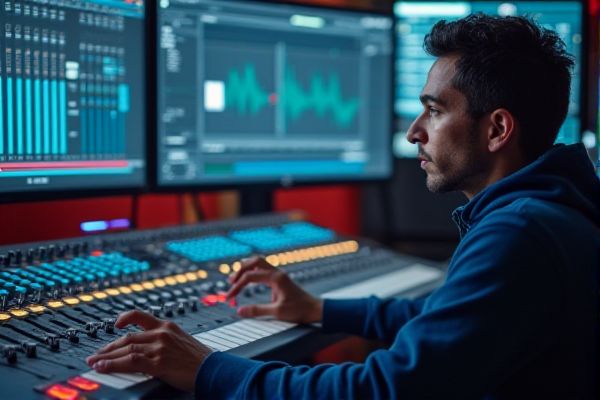
AI enhances audio production by automating repetitive tasks, allowing engineers to focus on creativity. Machine learning algorithms analyze sound patterns and assist in mixing and mastering processes, ensuring high-quality outputs. Virtual instruments and AI-driven plugins offer musicians new soundscapes and innovative ways to compose. Real-time audio analysis tools provide feedback and optimization suggestions, streamlining workflows and improving overall efficiency.
AI usage in audio production
Automated Mixing
Automated mixing in audio production offers the possibility of reducing manual labor and enhancing efficiency. Algorithms can analyze audio tracks, adjusting levels and equalization to achieve a polished sound with minimal input. For example, software like iZotope Ozone utilizes machine learning to assist engineers in creating professional mixes. This technology may provide significant advantages in time management and consistency, making it an appealing choice for studios and independent producers alike.
Audio Enhancement Algorithms
AI usage in audio production can significantly improve sound quality through advanced audio enhancement algorithms. These algorithms, such as noise reduction and equalization, can optimize recordings by removing unwanted sound artifacts and balancing audio frequencies. For instance, software like iZotope RX utilizes AI to enhance voice clarity in podcasts and music tracks. The potential advantages include streamlined production processes and elevated audio fidelity, leading to a more professional final product.
Noise Reduction Technology
AI usage in audio production can enhance the quality of sound by applying advanced noise reduction technology. This allows for clearer recordings by minimizing unwanted sounds that may interfere with the intended audio. For instance, a professional studio like Abbey Road Studios could leverage AI tools to refine vocal tracks and improve overall mix clarity. The potential for AI to streamline workflow and enhance audio fidelity presents significant opportunities for sound engineers and producers alike.
AI-Powered Mastering
AI-powered mastering tools can streamline the audio production process, offering quicker turnaround times for sound engineers. These systems analyze audio tracks for optimal balance and clarity, potentially enhancing the final product's quality. Companies like LANDR exemplify how AI can aid in delivering professional-grade sound, making mastering accessible to independent musicians. Increased efficiency and affordability in mastering could encourage more artists to produce high-quality recordings without extensive studio resources.
Virtual Instrument Simulation
AI in audio production offers various possibilities for enhancing creativity and efficiency. For instance, virtual instrument simulation can provide realistic sounds that closely mimic acoustic instruments, allowing musicians to produce high-quality tracks without the need for physical instruments. This technology may also enable audio engineers to quickly generate complex sounds, reducing time spent in the studio. Companies like Native Instruments exemplify the advancements in this field, showcasing AI's potential to transform music production.
Speech Recognition and Transcription
AI can significantly enhance audio production by automating tasks such as mixing and mastering, which allows sound engineers to focus on creativity. In speech recognition applications, AI algorithms can accurately transcribe spoken language into text, as seen in tools developed by companies like Otter.ai. The potential for efficiency gains in transcription work makes AI an attractive option for businesses relying on accurate documentation. This technology not only speeds up the process but also reduces human error, showcasing its advantages across various fields.
Emotion and Sentiment Analysis
AI in audio production can streamline the editing process by automating tasks like noise reduction and sound enhancement. Emotion and sentiment analysis tools can be utilized to gauge audience reactions during music creation, potentially helping artists tailor their work to listener preferences. For example, a music producer may apply these technologies to optimize soundtracks for films, enhancing emotional impact. This synergy between AI and audio production offers the possibility of creating more engaging and personalized listening experiences.
AI-Driven Composition Tools
AI-driven composition tools can enhance audio production efficiency by generating musical ideas and arrangements, reducing the time spent on initial creativity. Programs like AIVA are examples of software that can assist composers in creating music tailored to specific genres or moods. The incorporation of AI can also lead to unique soundscapes that might not have been explored by human composers alone. This opens up opportunities for innovative projects in various fields, including film scoring and commercial jingles.
Voice Cloning and Synthesis
AI in audio production offers the possibility of enhanced efficiency and creativity through voice cloning and synthesis. Technologies such as deep learning enable the creation of realistic voice models, allowing producers to generate custom voiceovers for projects. This capability can significantly reduce the time and expense associated with traditional voice recording methods. Institutions like Stanford University are exploring these advancements, indicating a growing trend in the industry toward AI-driven audio solutions.
Real-time Audio Effects
AI usage in audio production can enhance the creative process by providing real-time audio effects. This technology enables sound engineers to manipulate sounds dynamically, allowing for richer auditory experiences in music and film. For example, institutions like Berklee College of Music are exploring AI tools to streamline mixing and mastering tasks. The possibility of automating routine processes frees artists to focus on their creative vision, maximizing their potential output.
 techknowy.com
techknowy.com